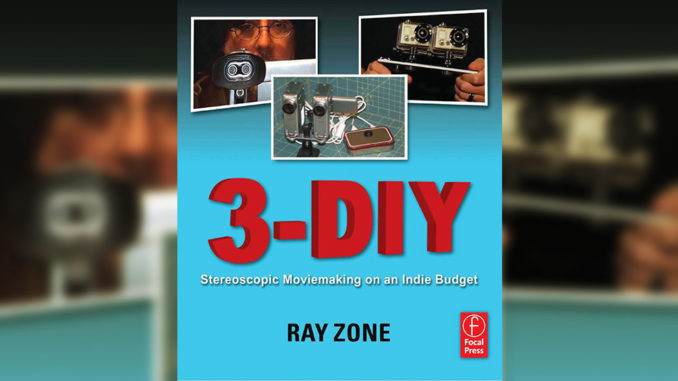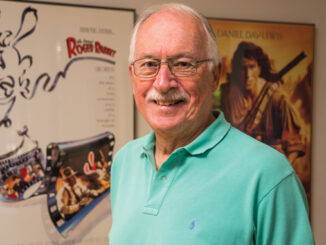
by Betsy A. McLane
3-DIY: Stereoscopic Moviemaking on an Indie Budget
by Ray Zone
Focal Press
Paperbound, 378 pps., $34.95
ISBN: 978-0-240-81707-1
An overlooked phenomenon, 3D film production based in the home moviemaking tradition is explored and explodes in Ray Zone’s new book, 3-DIY: Stereoscopic Moviemaking on an Indie Budget. “Explodes” is the correct word since many of the numerous color photographs are printed in 3D, best viewed with the familiar red and cyan glasses — thoughtfully included inside the front cover.
There is no one better suited to writing this important work than Zone, who is also the book reviewer for this publication. Along with being a 3D filmmaker, he has created over 150 3D comic books and is a prolific author. His books include 3D Filmmakers: Conversations with Creators of Stereoscopic Motion Pictures (2005), and a personal favorite, Stereoscopic Cinema and the Origins of 3-D Film, 1838-1952 (2007). The latter was reviewed in Editors Guild Magazine, MAY-JUN 08.
This new book completes Zone’s essential trilogy about 3D. It begins with an all-too-brief Introduction to stereoscopic technique in relation to amateur moviemaking. The word “amateur” is used in the Introduction in its first, best definition: “a person who engages in an art, science, study or athletic activity as a pastime rather than as a profession.” The practitioners of do-it-yourself 3D are supremely skilled and passionate artists, scientists and students of film who dedicate an enormous amount of time and money to their craft. The brilliance of their work can exceed that of some professionals who might put down DIY.
In his Introduction, Zone points out that by 1952, the Nord Company of Minneapolis had produced a practical three-dimensional attachment for single-strip 16mm cameras and projectors. At the time, American Cinematographer noted, “Stereo movies, long in the experimental stage, are now a practical thing for the movie amateur — even before they are commercially possible for theatres.” A stereo Bolex outfit was also announced in 1952, including accessories and a special screen. The author claims that the components for this system are available on the Internet today and can be purchased for less than the original sales price of $397.50.
The 3-DIY stories are not only for technical cognoscenti. Reading about the adventures of shooting 3D in black light or during a free-fall skydive are fascinating, and the book’s many photographs popping from the page are a treat.
The bulk of 3-DIY is composed of 23 chapters, each detailing the work of one, sometimes two stereoscopic auteurs. In this format, Zone allows the makers to express themselves and explain their goals, techniques and tricks for successful production. Profiles include a stop-motion animated homage to bad films by Alexander Lentjes; Phil McNally’s effort to make a short film to get a job in Hollywood; Zoe Beloff, who creates apparitions in 3D; and Tashi Sekitani, who almost incongruously created Doggycam Vista, a walk around Japan seen from a dog’s ground-level POV.
As a member of the Tokyo 3D Club, Sekitani represents another subject thoroughly explored in the book: the growth and importance of 3D societies. Zone is an active member of the LA 3D club, an outgrowth of the Photographic Society of America’s “Stereo Division.” Clubs around the world promote 3D filmmaking, offer forums to share techniques and equipment, and sponsor popular 3D festivals. The LA 3D Club offers open screenings every three months at the Downtown Theatre, to which anyone can bring his or her 3D pieces and show them on a 16-by-24-foot screen.
Digital technology in service to creativity is the key theme of 3-DIY, and Zone covers every technological possibility in staggering detail. The people who create 3D movies are not only fascinating artists — they are scientists, inventors and technicians of the first order. Each tackles the challenges of 3D in idiosyncratic and brilliant ways. These include not only the usual story, pre-production, shooting, sound and picture editing, and exhibition stages of any film, but also the actual construction of the tool kits necessary to make 3D.
The author’s mind-boggling iteration of technical detail provides enough information and options for anyone — who has or wants to develop superb skills — to make their own films. Even with chapter headings like “The World’s First 720p International Skype 3D”, “Creating Abstract CG Animation on the Z-Axis”, and “Editing with Cineform Neo3D”, 3-DIY is much more than a manual.
This new book completes Ray Zone’s essential trilogy about 3D.
Santa Monica Pier (2010) is the title of the film featured in a chapter primarily devoted to editing. (Editing of both sound and picture is also discussed in other chapters.) It was made by Stephen Les, founder of the 3D editing business Amazing 3D Post. Since his main interest was editing, the film was shot with the relatively simple Fuji W1, which houses two sensors in a single unit and, with 640 x 480 standard definition, produces an image quality acceptable for large-screen projection. The Santa Monica Pier, with its carnival rides and crowds of people, provided plenty of visuals, both still and moving, as well as varied sounds — even with only three hours of shooting. These are edited together in a way that captures both the momentum of activity on the pier and the moments of excitement caught on a person’s face. The stills allow the 3D images to register with the eye just long enough to engage the viewer and transition attention to movement within the frame.
The following lengthy, but typical, quote illustrates not only Les’ work, but also Zone’s explanation of 3D workflow:
“First I took the native AVI files from the W1, and split them into two separate eyes with FinePix Viewer. Then I created a setting in compressor that transcoded the AVI files to ProRes files. I then opened the ProRes files in ReMaster and transcoded them again into the Cineform codec.”
The next step was to import the Cineform files into First Light. Here, the separate eyes were reunited into one stereo video clip. Les viewed the clips in red/cyan anaglyph and in First Light adjusted all the 3D parameters, including convergence and vertical alignment. Without using the glasses, he adjusted the color so that the two eyes matched. He then imported the “muxed” clip into Final Cut Pro and edited in Final Cut Pro in anaglyph.
The 3-DIY stories are not only for technical cognoscenti. Reading about the adventures of shooting 3D in black light or during a free-fall skydive are fascinating, and the book’s many photographs popping from the page are a treat. “3-DIY moviemaking is about to enter a golden age of independent production,” Zone writes. It certainly is an art form that is increasingly accessible. As an example, animator Eric Kurland explains how to shoot a 3D movie using two Canon consumer cameras with a switch housed in an Altoids box. He can then view the film on the screen of a Sony monitor mounted onto the optics of an antique stereoscope.
As the author makes stereoscopically clear, everything old is new again. And if you want to join this ongoing revolution and try your hand at 3D filmmaking — in any of its many forms — 3-DIY is the book for you.
Be certain to watch the 3D films discussed in this book at www.youtube.com/user/ejkdreamer.






